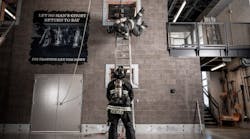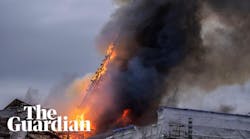In a previous article (August 2007), we covered the purpose of live-fire training, which is to reinforce and expand our firefighting knowledge base and skill level, with the goal of enhancing our fireground safety. We will switch gears this time and discuss human error as it relates to preparing for and conducting structural live-fire training.
Researcher James Reason, in his book Managing the Risks of Organizational Accidents, describes the main principles of error management:
- The best people can sometimes make the worst errors.
- Short-lived mental states — preoccupation, distraction, forgetfulness and inattention — are the last and least manageable part of the error sequence.
- People will always make errors and commit violations, but we can change their working conditions to make unsafe acts less likely.
- Blaming people for their errors, though emotionally satisfying, will have little or no effect on their future fallibility.
- Errors are largely unintentional. It's difficult for management to control what people didn't intend to do in the first place.
- Errors arise from informational problems. They are best tackled by improving the available information, either in the person's head or in the workplace.
- Violations are social or motivational problems. They are best addressed by changing people's norms, beliefs, attitudes and culture, as well as by improving the credibility, applicability, availability and accuracy of procedures.
- Violations increase the likelihood of violators committing subsequent errors, which in turn are more likely to have damaging consequences.
The latest edition of the National Fire Protection Association (NFPA) 1403, Standard on Live-Fire Training Evolutions, was published in 2007, so if you have an earlier edition, go to www.nfpa.org now and purchase a copy. Every instructor should own one. Read and understand this document — this is essential if you are involved in the serious business of live-fire training. Place it into practice.
One important objective of live-fire training is for the instructor in charge to identify, plan for and manage human error that can (and will) occur during the live-fire training process. The details found in NFPA 1403 include setting up a number of training-ground redundancies that specifically account for the potential of human error to occur during the evolutions. The prudent instructor in charge is also smart enough to realize that he or she is subject to making errors. The most qualified fire instructors know they need the assistance of the best live-fire training management team possible.
Preparing to use an acquired structure for live-fire training is a work-intensive project. Never underestimate the breadth of experience required to effectively prepare the building and conduct the evolutions for effective live-fire training. To maximize safety, potential hazards must be minimized and an acceptable risk environment produced for the students. This is the responsibility of the instructor in charge.
One personal characteristic of a prudent instructor in charge is the recognition of one's own limitations as it relates to preparing the building and conducting the training evolutions to maximize student safety. Perhaps an instructor, a friend of mine, sums up the situation best. Every now and then, we get together and discuss recent events in the news. This includes things that have gone seriously wrong in the field. When discussing training activities that have gone awry, my friend usually points out what "Dirty Harry" once said: "A man's got to know his limitations."
While an instructor in charge may have a good handle on what NFPA 1403 states is required to conduct live-fire training, much more knowledge and skill is needed for effective live-fire training outcomes. Some personnel can have a false sense of readiness. These poor souls can become a victim of a phenomenon I call the "wedding and funeral syndrome." The fundamental idea and concept is that it is difficult for the average person to become an expert at preparing for weddings and funerals since a person typically only marries once (yes, the "lucky" ones marry twice or three times), and certainly a person only dies once. They are low-frequency events. To take care of the many details of a wedding, some people hire a "wedding planner." Since planning a wedding is a low-frequency event, hiring a subject-matter expert to guide the soon-to-be-married couple can make good sense. Not using a planner could lead to a bad wedding day experience and possibly a costly lesson.
A capable fire officer with limited instructional and hands-on NFPA 1403 experience can have real challenges organizing a live-fire training session and executing the evolutions as the instructor in charge. For an example of this scenario, a chief in a rural or suburban location may not have access to a fixed reusable burn building. Occasionally, an acquired structure becomes available for fire training. Since this may happen once a year, or every few years, it is a low-frequency event. While there is good intent in using the acquired structure for much-needed training, since there may not be local subject-matter experts available to assist in structure preparation and conducting the training, the execution of the training process and its outcome could be horrible.
What sometimes happens in situations like this is a structural live-fire training exercise that runs like a real-world structural fire response. Running a live-fire training evolution like a real-world structure fire response can be costly since it could expose the students to unacceptable risks. One key instructor-in-charge qualification to look for is the realization that he or she knows his or her own limitations — that's the understanding that by surrounding oneself with a group of qualified personnel, a superior safety net can be built to prevent becoming a victim of one's own blind spots. In other words, the officer realizing the need to enlist the assistance of live-fire training subject-matter experts as additional insurance so that important details and subtleties are not overlooked.
Unlike a wedding, where the worst thing that could happen is a bad day (well, about half of weddings end up being a "bad day," if you look at the divorce statistics), when conducting live-fire training the stakes are much higher — potential firefighter injury or fatality. Now that's the worst kind of bad day. I can think of at least one specific instance that stands out over my past 20 years' experience as an instructor in charge of live-fire training where my team of subject-matter experts saved my derriere. They identified a questionable condition I had missed that was vital to firefighter safety. The issue is simple: many qualified minds are much better at problem recognition and mitigation than a single qualified mind.
We would be glad to hear from you regarding the topic of error management as it relates to live-fire training. If you have tips on how to improve the training ground that we can share with others to prevent injuries, we would like to hear them and look forward to hearing from you. Keep on training and stay safe!





